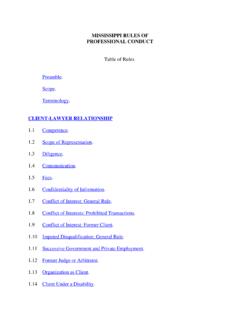Transcription of ARIZONA CODE OF JUDICIAL ADMINISTRATION Part 3: …
1 1 ARIZONA CODE OF JUDICIAL ADMINISTRATION Part 3: Superior Court Chapter 4: ADMINISTRATION Section 3-402: Superior Court Records Retention and Disposition A. Definitions. In this section the following definitions apply: Case file means the original documents or other material, regardless of physical form filed in an action or proceeding in a court, either in paper or electronic format. Closed means that the case is no longer subject to modification pursuant to Rule 94(h), rules of the Supreme Court. Date received, means the date records are received by the clerk or court. Destruction or destroyed means to discard by burning, shredding, recycling, or by depositing in a public landfill. Dispose means to destroy a record or transfer a record to archives, depending upon the context. File or filed means the record was delivered to and file-stamped by the Clerk of Court.
2 Historically significant case means a case involving a unique legal issue or controversy, prominent party, or other high profile or newsworthy aspects, and that has been so designated pursuant to the process established in subsection (F) of this section. Landmark case means a case that meets the requirements of Rule 111(b), rules of the Supreme Court, has been the subject of a published appellate court opinion as that term is defined by Rule 111(a)(1), and has been so designated pursuant to the process established in subsection (F) of this section. Microfilming means the reproduction on microfilm of the original record in accordance with the minimum standards for microfilming as established by nationally accepted records and information management process standards. Purge means to remove and destroy records in a case file pursuant to subsection (D) of this section.
3 Retention period means the period of time during which records must be kept before they may be disposed of, usually a period of years and sometimes contingent upon an event, such as entry of judgment or after reference value served. 2 B. Authority. Az. Const. Art. 6, 3 and 23 authorize the supreme court to administer the courts of this state and to establish duties for the clerk of the superior court in each county by rule. 41-1339 requires superior court clerks to transfer permanent files to the Director of the ARIZONA State Library Archives and Public Records (ASLAPR) at the end of their prescribed retention period, pursuant to court rules . Rule 29, rules of the Supreme Court requires the court to adopt retention and disposition schedules and purge lists for court records. C. Retention and disposition schedule.
4 Clerks shall retain and dispose of superior court records according to the following schedule: ARIZONA SUPREME COURT Records Retention and Disposition Schedule FOR USE BY SUPERIOR COURT Type of Record Retain (Yrs)Remarks 1. COURT CASE FILES Case records designated for retention for a period of 50 years (for cases filed after 1959) must be transferred to the state archivist for permanent storage and not destroyed at the end of the 50 year retention period. For example, in the year 2011, a civil malpractice case record filed in 1960 must be transferred to the state archivist. Case records designated for retention for a period of Permanent (for cases filed prior to 1960) may be either retained in the custody of the clerk of court or transferred to the state archivist and not destroyed. For example in the year 2011, a civil malpractice case record filed in 1959 may be transferred to the state archivist or retained by the clerk at the clerk s discretion.
5 3 ARIZONA SUPREME COURT Records Retention and Disposition Schedule FOR USE BY SUPERIOR COURT Type of Record Retain (Yrs)Remarks a. Civil General Includes: - Administrative review - Contract - Declaratory judgment - Department of Economic Security (DES) instant judgment - Eminent domain - Foreign judgment - Habeas corpus - Malpractice - Name change - Non-general stream adjudication water rights - Quiet title - Restoration of civil rights - Special action appeal - Tax appeal - Tort general (all non-motor vehicle) - Transcript of judgment - Other unspecified non-domestic relations civil case categories 50 (for cases filed after 1959) _____ Permanent (for cases filed prior to 1960) Retention period begins following year filed. As provided by Rule 29, rules of the Supreme Court, at the end of the retention period required by this section, transfer these court records to ASLAPR for permanent retention.
6 Purging and microfilming are allowed at any point after the case is closed. (See subsection D). _____ Purging and microfilming are allowed at any point after the case is closed. (See subsection D). (1) Civil Other - Forcible detainer - Harassment - Seized vehicle - Tort motor vehicle 10 Retention period begins following year filed. Case file may be destroyed at end of retention period. Microfilming and/or transfer to ASLAPR not required. Applies to all records currently in custody, including pre-1960 records. (2) Domestic Relations Cases - with children - Civil paternity - Domestic custody 75 (for cases filed after 1959) Retention period begins following the year filed. As provided by Rule 29, rules of the 4 ARIZONA SUPREME COURT Records Retention and Disposition Schedule FOR USE BY SUPERIOR COURT Type of Record Retain (Yrs)Remarks - Domestic violence - Reciprocal divorce - Support enforcement _____Permanent (for cases filed prior to 1960) Supreme Court, at the end of the retention period required by this section, transfer these court records to ASLAPR for permanent retention.
7 These files shall not be purged. Microfilming is allowed at any point after the case is closed. (See subsection D). _____ These files shall not be purged. Microfilming is allowed at any point after the case is closed. (See subsection D). (3) Domestic Relations Cases without children - Dissolutions - All other unspecified domestic relations case categories 50 (for cases filed after 1959) _____ Permanent (for cases filed prior to 1960) Retention period begins following the year filed. As provided by Rule 29, rules of the Supreme Court, at the end of the retention period required by this section, transfer these court records to ASLAPR for permanent retention. These files shall not be purged. Microfilming is allowed at any point after the case is closed. (See subsection D). _____ These files shall not be purged.
8 Microfilming is allowed at any point after the case is closed. (See subsection D). (4) Dismissed Domestic Relations Cases -- with or without children 50 (for cases filed after 1959) Retention period begins following the year filed. As provided by Rule 29, rules of the Supreme Court, at the end of the retention 5 ARIZONA SUPREME COURT Records Retention and Disposition Schedule FOR USE BY SUPERIOR COURT Type of Record Retain (Yrs)Remarks _____ Permanent (for cases filed prior to 1960) period required by this section, transfer these court records to ASLAPR for permanent retention. Purging and microfilming are allowed at any point after the case is closed. (See subsection D). _____ Purging and microfilming are allowed at any point after the case is closed. (See subsection D). (5) Orders of Protection/Injunctions Against Harassment 5 Retention period begins following the year filed.
9 Case file may be destroyed. Microfilming and/or transfer to ASLAPR not required. (6) Demand for Notice (including non-case specific filings, ARIZONA Health Care Cost Containment System (AHCCCS) clients who have died) 2 After date received. Document may be destroyed. (7) Mental Health 50 (for cases filed after 1959) Retention period begins following year filed. As provided by Rule 29, rules of the Supreme Court, at the end of the retention period required by this section, clerks shall transfer these court records to ASLAPR for permanent retention. Not authorized for purging. Microfilming is allowed at any point after the case is closed. (See Subsection D). 6 ARIZONA SUPREME COURT Records Retention and Disposition Schedule FOR USE BY SUPERIOR COURT Type of Record Retain (Yrs)Remarks _____ Permanent (for cases filed prior to 1960) _____ Not authorized for purging.
10 Microfilming is allowed at any point after the case is closed. (See subsection D). (8) Probate Includes: - Conservatorship - Combination Conservatorship/Guardian-ship - Guardianship (adult and juvenile) - Adult adoptions - Non-case specific filings 100 (for cases filed after 1959) _____ Permanent (for cases filed prior to 1960) Retention period begins following the year filed. As provided by Rule 29, rules of the Supreme Court, at the end of the retention period required by this section, clerks shall transfer these court records to ASLAPR for permanent retention. Not authorized for purging. Microfilming is allowed at any point after the case is closed. (See Subsection D). _____ Not authorized for purging. Microfilming is allowed at any point after the case is closed. (See subsection D). - Probate vouchers and receipts 5 After fiscal year received or after final annual accounting.









